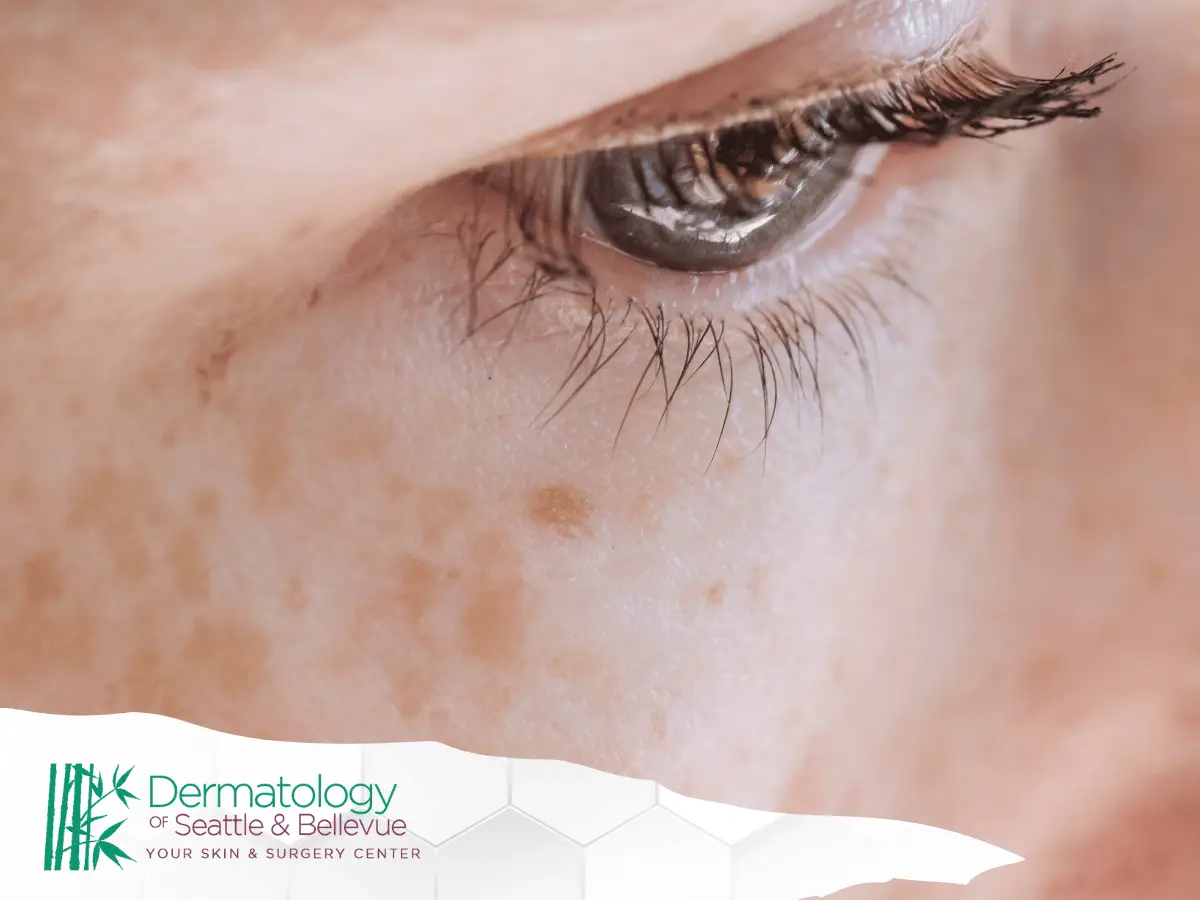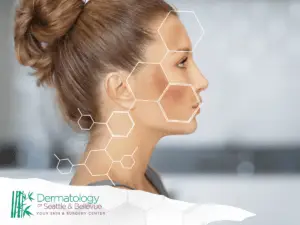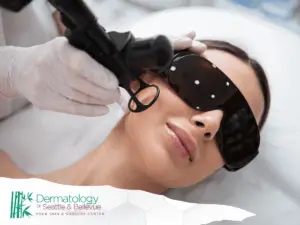It’s not uncommon to have freckles that stay on your skin for years—sometimes even decades—without issue. But when it comes to skin health, nothing should be ignored. While most freckles are harmless, it’s important to understand when a long-standing freckle could signal something more serious, like skin cancer. Early recognition is key, and this blog breaks down what to watch for and when to take action.
Quick Summary
- Freckles are flat, pigmented spots (ephelides) that darken with sun and usually appear in childhood; they’re due to more melanin, not more cells.
- Skin cancer (BCC, SCC, melanoma) is abnormal skin cell growth, often from UV damage; melanoma can be aggressive if not caught early.
- Freckles don’t turn into cancer, but cancers can look like freckles, and melanoma may arise near a freckled, UV-exposed area.
- Watch ABCDE changes plus itching, bleeding, crusting, darkening, or becoming raised; see a dermatologist if a long-stable spot evolves.
- Prevent with SPF 30+ daily, reapply every 2 hours, avoid tanning beds, and do monthly self-checks plus regular dermatologist exams.
What are freckles?
Freckles are small, flat spots on the skin that contain more pigment than the surrounding area. They often appear as tan, brown, or light red marks and tend to show up on sun-exposed areas like the face, shoulders, arms, and chest. People with lighter skin and hair tones—especially redheads—are more likely to have them.
Definition of freckles
Freckles, medically called ephelides, are:
- Caused by an increase in melanin (not more melanocytes)
- Triggered or darkened by sun exposure
- Usually uniform in shape and color
- Most commonly appear in childhood or adolescence
- Typically fade with less sun exposure or over time
Understanding skin cancer
Skin cancer is the abnormal growth of skin cells, often triggered by damage from ultraviolet (UV) radiation. It can develop anywhere on the body but is most common in sun-exposed areas. While some types are slow-growing and treatable, others like melanoma can be aggressive and spread quickly if not caught early. In addition to UV exposure, certain factors can increase the likelihood of developing skin cancer. Individuals with body art may face heightened skin cancer risks from body art, particularly if the tattoos have been applied improperly or if they lead to skin irritation. Regular skin checks and consultations with a dermatologist are essential for early detection and to manage any potential risks effectively.
Types of skin cancer
There are several primary types of skin cancer:
- Basal cell carcinoma (BCC): Most common; usually slow-growing.
- Squamous cell carcinoma (SCC): Can spread if untreated; often linked to long-term sun damage.
- Melanoma: Less common but more dangerous; arises from pigment-producing melanocytes and can start in or near a freckle or mole.
Causes of skin cancer
Most cases of skin cancer result from long-term exposure to ultraviolet (UV) radiation, which can damage DNA in skin cells. Key risk factors include:
- Frequent sunburns or tanning bed use
- Having fair skin, light eyes, or red/blond hair
- Family history of skin cancer
- A large number of moles or atypical moles
- Compromised immune system
Relationship between freckles and skin cancer
Freckles are generally benign pigmented spots that result from sun exposure and genetic predisposition. They are not the same as moles and, on their own, are not considered precancerous. However, because they indicate sun-sensitive skin, they can be a marker of increased risk for skin cancer, especially in individuals who have many freckles or a history of sunburns.
Can freckles turn into skin cancer?
Freckles themselves do not transform into cancer, but:
- A cancerous lesion can be mistaken for a freckle.
- Melanoma may develop in an area where a freckle already exists, especially if that area has been repeatedly exposed to UV radiation.
- A freckle that changes in shape, size, or color should be evaluated, as it could be an early sign of skin cancer.
While freckles are not dangerous, any evolving skin spot should be checked by a dermatologist.
Identifying skin cancer in freckles
Noticing changes in a long-standing freckle can be challenging, but it’s crucial to stay alert. Skin cancer, especially melanoma, may initially resemble a freckle or blend in with existing pigmentation. Monitoring changes over time is essential for early diagnosis and better outcomes.
Signs to look for
Recognizing when a freckle could be suspicious involves knowing the ABCDEs of melanoma:
- A – Asymmetry: One half doesn’t match the other.
- B – Border: Irregular, notched, or blurred edges.
- C – Color: Multiple shades or changes in color over time.
- D – Diameter: Larger than 6mm (about the size of a pencil eraser), though smaller spots can be melanoma too.
- E – Evolving: Any change in size, shape, color, or texture.
Other warning signs include:
- Bleeding, itching, or crusting
- New growths in sun-exposed areas
- A freckle that suddenly appears darker or becomes raised
When to consult a dermatologist
It’s time to make an appointment if:
- A freckle begins to change after years of looking the same
- You notice new spots that look unlike others on your skin
- You have a family history of skin cancer
- You experience itching, pain, or bleeding from a freckle
Early consultation can lead to faster diagnosis and better treatment outcomes. Even if it’s nothing, peace of mind is worth it.
Preventative measures
Protecting your skin is the best way to reduce your chances of developing skin cancer, whether or not you have freckles. Daily habits and consistent awareness go a long way in preserving long-term skin health.
Protecting your skin from UV rays
Sun protection is essential for everyone, especially if you have freckles or a history of sunburns. Ultraviolet (UV) exposure is a major cause of skin cancer. Key protective steps include:
- Wearing broad-spectrum SPF 30+ sunscreen daily, even on cloudy days
- Reapplying sunscreen every 2 hours, or after swimming or sweating
- Wearing wide-brimmed hats, UV-protective sunglasses, and long sleeves
- Avoiding tanning beds and limiting time in direct sun (especially 10 a.m.–4 p.m.)
Daily habits make the biggest difference. Consistent protection over time reduces cumulative UV damage to the skin.
Regular skin checks
Routine self-exams and annual skin screenings help with early detection. Look over your entire body monthly—including your scalp, underarms, nails, and soles of your feet.
During your exam:
- Check for new or changing spots
- Use mirrors for hard-to-see areas
- Photograph spots you’re monitoring over time
A board-certified dermatologist can perform a full-body skin exam and recommend a screening schedule based on your personal risk factors.
Treatment options
If a freckle is diagnosed as cancerous, there are several effective treatment paths depending on the type and stage.
Surgical removal
For early-stage skin cancers, surgical excision is the most common treatment. The procedure involves removing the cancerous lesion along with a small margin of healthy skin. If caught early, this method typically results in a complete cure.
Other surgical techniques include:
- Mohs surgery – especially useful for facial or high-risk areas
- Cryosurgery – freezing abnormal cells with liquid nitrogen
- Curettage and electrodesiccation – scraping and cauterizing superficial cancers
Each approach is selected based on lesion size, depth, and location.
Other treatment options
If surgery isn’t ideal, alternative treatments may be recommended:
- Topical medications like imiquimod or fluorouracil for superficial cancers
- Radiation therapy for cases where surgery isn’t feasible
- Immunotherapy or targeted therapy for advanced melanomas
- Photodynamic therapy (PDT) for pre-cancerous or surface-level lesions
Your dermatologist will tailor treatment based on the cancer type, your medical history, and personal preferences.





